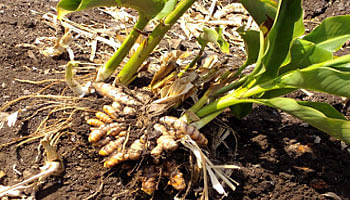
Introduction:
-
Turmeric is a part of Curcuma Long botanic group and it is a perennial herbaceous plant of the ginger family (Zingiberaceae).
-
It is used as a seasoning, dye, drug with diverse applications and also used in cosmetics industry.
-
It is used in various religious ceremonies.
-
India is a major producer and exporter of turmeric in the world.
Location:
-
The important states which cultivate turmeric are Andhra Pradesh, Tamil Nadu, Orissa, Karnataka, Wet Bengal, Gujarat, Meghalaya, Maharashtra and Assam.
-
Andhra Pradesh solely occupies 35.0% of area and 47.0% of Turmeric production.
Season:
In India, Turmeric cultivation is done in two seasons i.e., February-May and August-October.
Climate:
-
It is tropical herb which grows in both tropics and subtropics.
-
It can grow from sea level to 1500m above the sea.
-
It grows at a temperature range of 20-35°c with an annual rainfall of 1500mm or more.
-
It requires a humid climatic condition.
-
It is grown under rainfed or irrigated conditions.
Soil Requirement:
-
Soil used for Turmeric cultivation should be rich and friable.
-
It grows best in well drained sandy or clayey loam with a little higher sand content.
-
It grows on different types of soils from sandy loam, light black, clay loams to red soils with a pH range of 4.5-7.5 and should have a good organic status.
Land Preparation:
-
Minimum tillage operations should be adopted while preparing the land in Turmeric Farming.
-
To give at least 50cm spacing between beds, beds should be prepared with a height of 15cm, 1m width and suitable length.
-
In case of irrigated crops, rhizomes should be planted in shallow pits on the top of the ridges and ridges and furrows should be prepared.
-
Solarization of beds is useful to check the multiplication of pests and diseases causing organisms.
-
After the work is completed Polythene sheets which is used for soil solarisation should be kept away safely.

Spacing:
-
In the beds, with a hand hoe small pits are made in rows with a spacing of 25cm x 30 cm and it is covered with soil or dry powdered cattle manure.
-
The adequate spacing in furrows and ridges should be between 45-60cm and 25cm between the plants.
Varieties:
|
VARIETY |
MEAN YIELD (t/ha) |
CROP DURATION (days) |
DRY RECOVERY (%) |
CURCUMIN (%) |
OLEORESIN (%) |
ESSENTIAL OIL (%) |
|
Suguna |
29.3 |
190 |
12.0 |
7.3 |
13.5 |
6.0 |
|
Sudarshna |
28.8 |
190 |
12.0 |
5.3 |
15.0 |
7.0 |
|
Co-1 |
30.0 |
285 |
19.5 |
3.2 |
6.7 |
3.2 |
|
BSR-1 |
30.7 |
285 |
20.5 |
4.2 |
4.0 |
3.7 |
Sowing Time & Seed Rate:
-
Depending upon the variety and time of sowing, well grown turmeric crop is ready to harvest in 7-9 months.
-
The crops can be planted in April- March with the arrival of pre-monsoon showers where the rainfall comes early.
-
For planting one hectare of turmeric a seed rate of 2500 kg of rhizomes is required.
Irrigation:
-
Irrigation is done depending upon the soil and climatic conditions for turmeric.
-
In case of medium heavy soils, 15-25 irrigations are given depending on the rainfall.
-
In case of light textured red soils, 35-40 irrigations are needed.
Manure & Fertilizers:
-
Farmers use natural fertilizers, animal dung for a good crop and for the maximum output and avoid using other harmful pesticides and chemicals.
-
While planting rhizomes in the pits application of well rotten cow dung and compost from their own farm at 2-3tonne/acre should be given as a basal dose.
Harvesting:
-
Harvesting is done from January- April
-
Early varieties mature in 7-8 months and medium varieties in 8-9 months.
-
When leaves turn yellow and starts drying it means that the crop is ready for harvesting.
-
At maturity, leaves are closely cut to the ground, the land is plowed well and rhizomes are collected by handpicking or with spade clumps.
-
The rhizomes that are picked are collected and cleaned.
-
Before curing, mother and finger rhizomes are separated.

Storage:
-
Rhizomes are piled up under the tree shade or in ventilated sheds and covered with turmeric leaves.
-
The heap is plastered over with earth mixed with cow dung.
-
The seed rhizomes can store in pits with sawdust.
-
It can be covered with wooden planks with 1 or 2 holes of aeration.
Yield:
-
The pure crop yield differs from 8000-10,000 kg per acre.
-
Plenty of manuring and copious irrigation may lead to high yield of 12,000 kg per acre.









